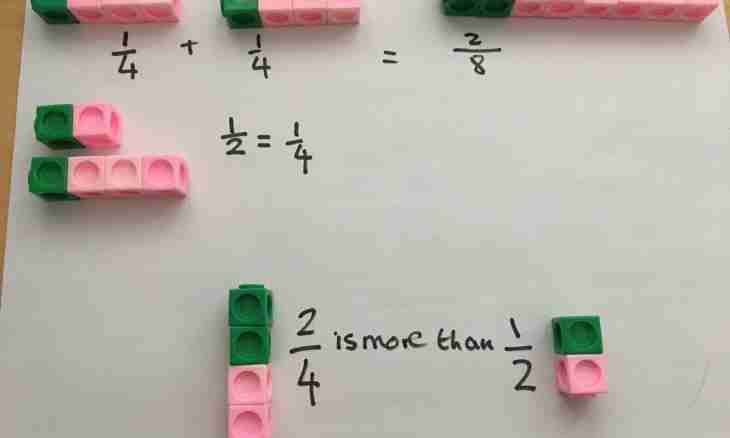To learn to solve fractions simply. However some pupils, having got confused in a set of new terms, cannot understand more difficult concepts connected with fractions. Therefore studying arithmetic actions with fractions needs to be begun from "beginning" and to pass to more difficult subject only after full assimilation previous.
It is required to you
- - calculator;
- - paper;
- - pencil.
Instruction
1. At first remember that the fraction is only conditional record of division of one number on another. Unlike addition and multiplication, at division of two integers the integer not always turns out. Here also agreed to call these two "sharing" numbers fraction. That number which is divided was called numerator, and into what divide - a denominator.
2. To write down fraction, write at first its numerator, then draw a horizontal line under this number, and below the line write a denominator. The horizontal line dividing numerator and a denominator is called fractional line. Sometimes it is represented in the form of inclined line "/" or "∕". At the same time, the numerator registers to the left of line, and a denominator on the right. So, for example, the fraction "two third" will register as 2/3. For descriptive reasons the numerator is usually written in the top part of a line, and a denominator - in lower, that is instead of 2/3 it is possible to meet: ⅔.
3. If the numerator of fraction is more than its denominator, then such "wrong" fraction is usually written down in the form of the "mixed" fraction. To receive from an improper fraction mixed, just divide numerator into a denominator and write down the received private. Then place a remainder of division in numerator of fraction and write down this fraction to the right of private (do not touch a denominator). For example, 7/3 = 2⅓.
4. To put two fractions with an identical denominator, just put their numerators (do not touch denominators). For example, 2/7 + 3/7 = (2+3)/7 = 5/7. Similarly you make also subtraction of two fractions (numerators at the same time are subtracted). For example, 6/7 – 2/7 = (6-2)/7 = 4/7.
5. To put two fractions with different denominators, increase numerator and a denominator of the first fraction by a denominator of the second, and numerator and a denominator of the second fraction – by a denominator of the first. As a result at you the sum of two fractions with identical denominators which addition is described in the previous point will turn out. For example, 3/4 + 2/3 = (3*3)/(4*3) + (2*4)/(3*4) = 9/12 + 8/12 = (9+8)/12 = 17/12 = 1 5/12.
6. If denominators of fractions have common divisors, that is are divided into the same number, choose the smallest number which is divided into the first and second denominator at the same time as a common denominator. So, for example, if the first denominator is equal 6, and the second 8, then as a common denominator take not their work (48), but number 24 which is divided both into 6, and on 8. Numerators of fractions at the same time are multiplied by private from division of a common denominator into a denominator of each fraction. For example, for a denominator the 6th such number will be 4 – (24/6), and for a denominator 8 – 3 (24/8). More visually this process is visible on a concrete example: 5/6 + 3/8 = (5*4)/24 + (3*3)/24 = 20/24 + 9/24 = 29/24 = 1 5/24. Subtraction of fractions with different denominators is made absolutely similarly.
7. To increase two fractions, multiply among themselves their numerators and denominators. For example, 2/3 * 4/5 = (2*4)/(3*5) = 8/15.
8. To divide two fractions, increase the first fraction by the turned (return) second fraction. For example, 2/3: 4/5 = 2/3 * 5/4 = 10/12.
9. To reduce fraction, divide its numerator and a denominator into the same number. So for example, the result of the previous example (10/12) can be written down as 5/6:10/12 = (10:2)/(12:2) = 5/6.

